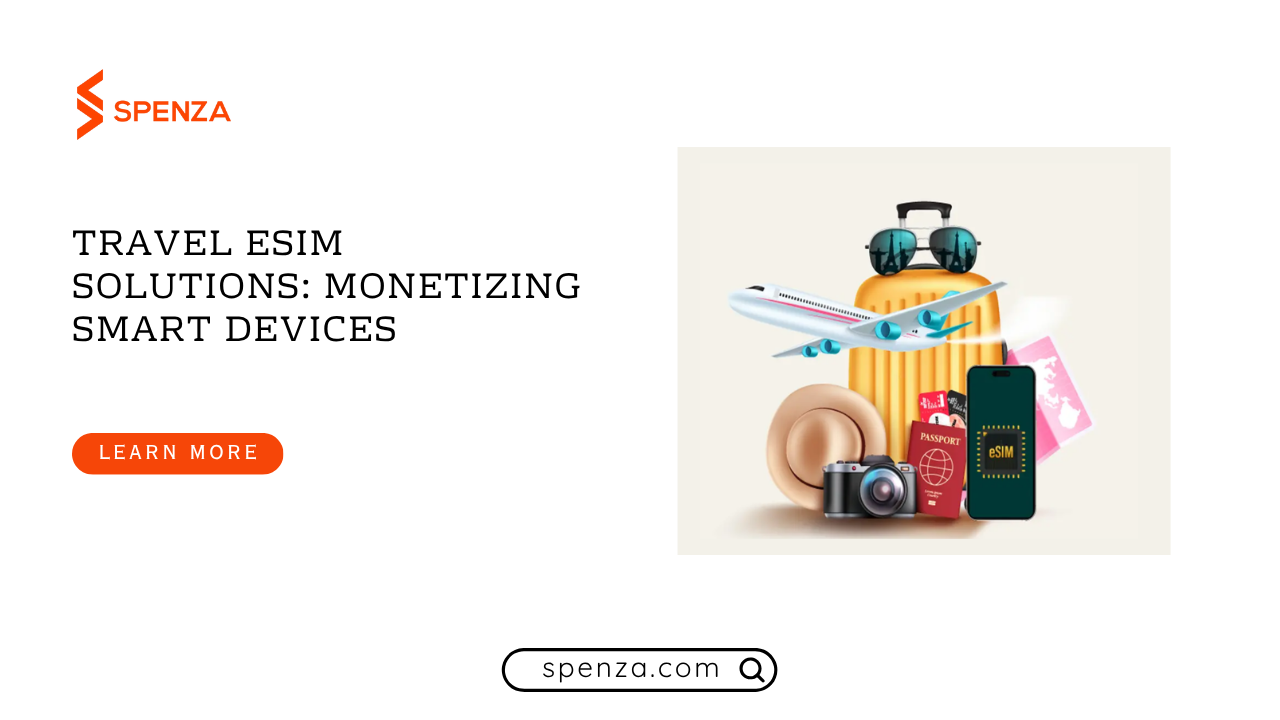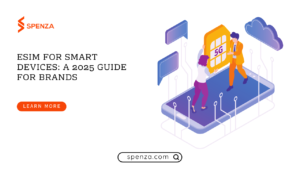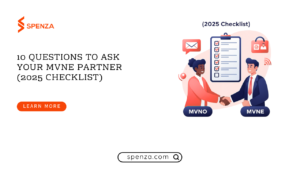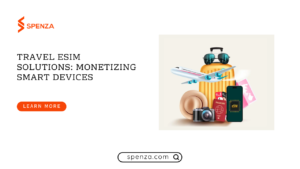Table of Contents
- Introduction
- The Growth of Travel eSIM Beyond Phones
- Smartwatches and Wearables
- Tablets and Laptops
- IoT Devices
- eSIM Adoption by Device Type
- Why Travel eSIM Is a Revenue Engine
- Direct Consumer Travel Plans
- Subscription Services
- Bundled IoT Services
- Pricing Models That Work
- The Market Momentum: U.S. and Global Combined
- Implementation Made Simple with Spenza
- Instant Global Network
- Simple API Integration
- A True White-Label Solution
- Zero-Hassle Backend
- Making the Business Case with Spenza
- Example: Wearable Manufacturer
- Example: IoT Asset Tracker
- Steps to Launch with Spenza
- How Spenza Handles Scale
- Conclusion: Transform Your Devices from Products to Global Companions
- FAQs
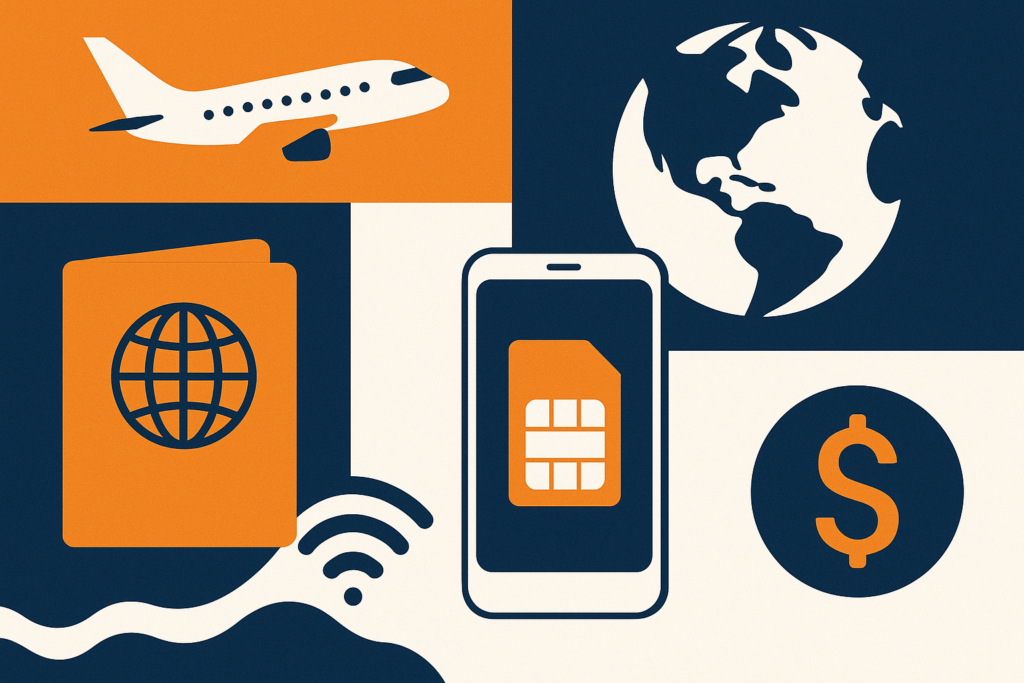
Introduction
What happens when your customers take their devices abroad and the connection stops? They stop using the product. They might even remove it from their daily routine. That silent churn is a hidden cost for every hardware brand. In a market where keeping customers active means keeping them paying, that gap is expensive.
Travel eSIM solutions like Spenza remove that problem. We make it possible for your customers to use your device in 190+ countries without swapping SIM cards or paying roaming fees that feel like a penalty. In 2023, the global eSIM market was worth $4.4 billion and is set to hit $16 billion by 2027, growing at 30% CAGR. The technology is not just for phones.
If your hardware already contains an eSIM chip, you can sell global data plans without redesigning the product. That means more revenue from your existing customers. The only step is making the travel plan part of your product experience, something Spenza’s IoT eSIM introduction explains in detail for OEMs and IoT companies.
What Would You Get by the End of the Article?
- Understand how travel eSIM solutions create recurring revenue for smart device makers.
- See how international connectivity for wearables, tablets, and IoT devices drives loyalty.
- Learn market data proving the rise of eSIM adoption globally and in the U.S.
- Identify clear business models to monetize travel connectivity without telecom buildouts.
- Recognize profitable pricing models for global data plans that appeal to consumers.
- Discover why eSIM for device manufacturers is now simple with the right partner.
The Growth of Travel eSIM Beyond Phones
Smartphones were the first consumer devices to make eSIM mainstream, but now the momentum is clearly shifting toward other categories. That change matters for any OEM thinking about eSIM for device manufacturers.

Smartwatches and Wearables
Around 30% of global smartwatch shipments in 2023 included cellular connectivity, and nearly all of them used eSIM. In the U.S., every major carrier allows adding these watches to an existing plan.
That means the hardware is already capable of activating a roaming eSIM for travel. A smartwatch runner flying from New York to Paris can activate a France plan right from their watch. Your brand could be the one selling that plan.
Tablets and Laptops
By 2024, more than 50% of new U.S. tablets will ship with eSIM built in. High-end devices like iPads and Surface laptops already support adding local data plans directly in settings. For a business traveler, this means opening the lid at a café in Tokyo and connecting instantly. For the OEM, it means a new monetized travel connectivity channel baked into the device’s interface.
IoT Devices
By 2025, 28% of all global cellular IoT connections will use eSIM, up from about 10% in 2023. This includes asset trackers, connected cars, payment terminals, and industrial sensors.
With eSIM, a logistics sensor shipped from Chicago can work in 100+ countries without hardware changes. This is the same principle Spenza’s integrated connectivity management platform uses to make multi-country IoT deployments possible from day one.
eSIM Adoption by Device Type
Before looking at the numbers, remember that each percentage here represents millions of devices already capable of adding travel eSIM solutions. For an OEM, these aren’t abstract market stats; they’re install bases ready to buy global data plans from you instead of a carrier.
| Device Category | eSIM Adoption 2023 | Projected 2025 |
|---|---|---|
| Smartphones | 20% | 50% |
| Smartwatches/Wearables | 30% | 50% |
| Tablets & PCs | 15% | 35% |
| IoT Devices | 10% | 28% |
The acceleration is clear. Smartphones will move from one in five to one in two devices supporting eSIM in just two years. Smartwatches and wearables will match that pace. IoT connections will nearly triple in share. Every one of these increases is a bigger addressable market for travel eSIM solutions offered under your brand.
Why Travel eSIM Is a Revenue Engine
Adding travel eSIM solutions to your devices changes the business model from one-time sales to continuous earnings. There are three proven ways to make that work.
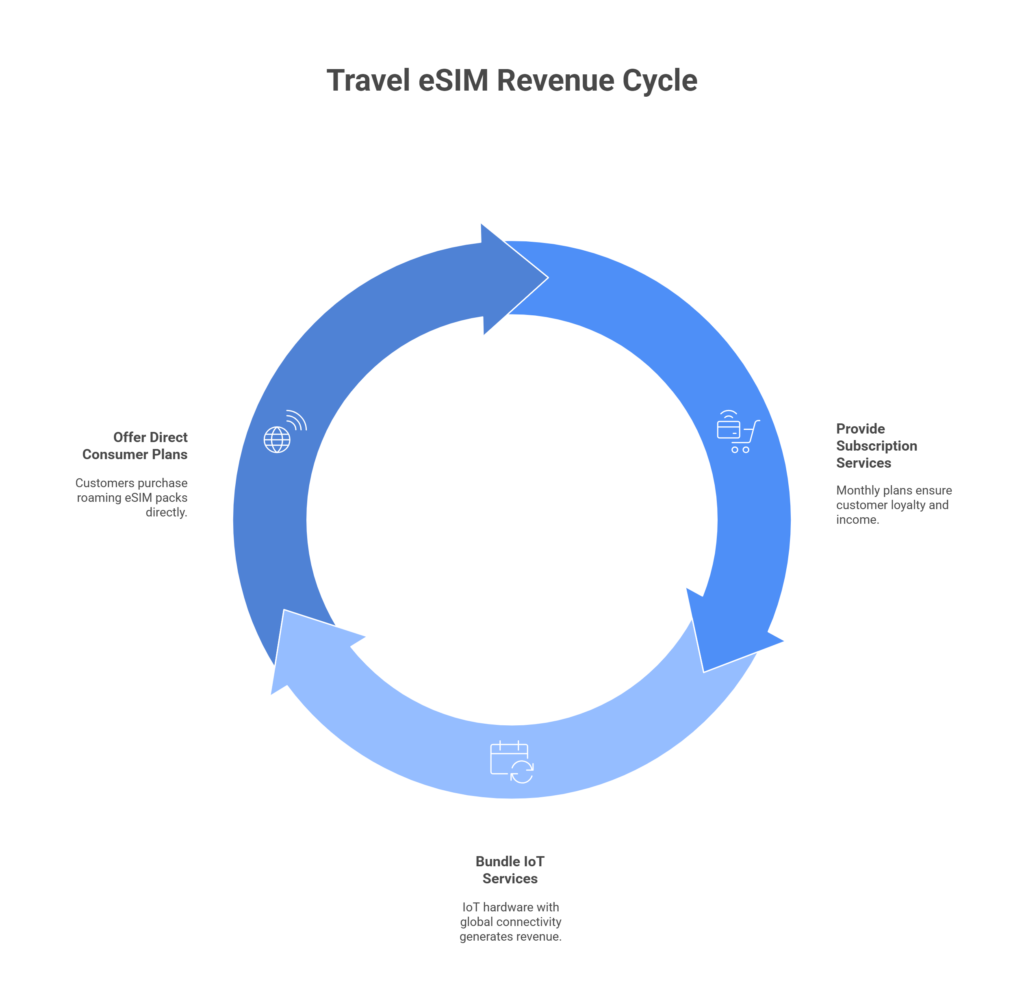
1. Direct Consumer Travel Plans
Customers buy a roaming eSIM pack right inside your app or device OS. For example, $20 for 5 GB valid across Europe. Wholesale costs for that data may be $3–$5 per GB. The rest is your gross margin. You control the brand, the payment, and the upsell opportunities.
2. Subscription Services
Sell a monthly plan that works domestically and internationally. Example: $10/month for smartwatch connectivity in 50+ countries. That keeps customers tied to your brand and creates predictable income.
3. Bundled IoT Services
Offer IoT hardware with built-in global connectivity. Bill per device per month. A connected vending machine in Berlin works just like one in Boston. You own the service relationship. Spenza’s MVNO IoT connectivity model makes it possible to manage this without your own telecom infrastructure.
Pricing Models That Work
Your travel eSIM solutions pricing can match your audience’s travel patterns.
- Pay-as-you-go packs: $10 for 1 GB, valid 30 days. Ideal for vacationers.
- Subscriptions: $50/month for 5 GB in 100+ countries. Targets frequent flyers.
- Freemium bundles: 500 MB free with purchase, upsell more data in-app.
Cost Advantage Example
| Scenario | Travel eSIM Cost | Carrier Roaming Cost |
|---|---|---|
| 1 GB in Europe | $10 | $70/week |
| 5 GB multi-country | $20 | $100+ for 10 days |
This difference is why customers switch, and why OEMs can sell global data plans at prices that feel like a win to the buyer and the business.
The Market Momentum: U.S. and Global Combined
The U.S. and international markets are moving fast in the same direction. In the U.S., Apple’s eSIM-only iPhone 14 launch in 2022 pushed carriers to make activation simple. Millions of Americans tried international eSIM plans for the first time in 2022–2023. That changed expectations, now, if a device has eSIM, consumers assume they can add a travel plan without a store visit.
Globally, Europe’s carriers embraced eSIM early, thanks to heavy cross-border travel. Asia-Pacific markets like Japan, Singapore, and Australia now offer eSIM across all major carriers. Tourist-heavy regions such as Thailand and UAE even sell eSIM QR codes in airports for instant activation.
On the IoT side, the need for one device SKU that works everywhere is driving adoption. A connected car or payment terminal with eSIM can ship to any country, download a local profile, and work without extra hardware. That is exactly the model explained in Spenza’s SGP.32 new eSIM standard guide, which shows how to make provisioning fast and secure across markets.
Market Size and Forecasts:
- Global eSIM value: $4.4 B in 2023 → $16 B by 2027 (30% CAGR).
- eSIM-enabled devices: 1.5 B in 2022 → 3.4 B in 2025.
- IoT cellular connections via eSIM: 10% in 2023 → 28% in 2025.
These aren’t soft trends. They are the early stages of a global standard. Travel eSIM solutions are becoming part of how customers expect their devices to work, just like Wi-Fi.
Implementation Made Simple with Spenza
The only question left is: how do you deliver this without building your own telecom operation?
That’s exactly what Spenza solves.
Spenza is a modern MVNE designed for both traditional MVNOs and IoT-focused deployments. The platform gives smart device manufacturers everything needed to run their own branded connectivity service. It’s cloud-native and API-first, which means it’s built for integration, not a patchwork of outdated telecom systems.
When you connect your devices to Spenza’s system, you get international eSIM provisioning, billing, usage analytics, and carrier management in one place. You don’t need to negotiate with dozens of networks or manage the complexity of SIM logistics. That’s already handled.
Instant Global Network
One of the hardest parts of selling travel eSIM solutions under your own brand is building a global footprint. Without that, you can’t offer your customers the same coverage they’d get from an established roaming plan.
Spenza has already done this work. The platform supports multi-carrier connectivity in over 190 countries. That includes major travel markets like the U.S., EU, Japan, Australia, and high-growth IoT regions in Asia and Latin America.
With Spenza, when your customer opens your device in a new country, the eSIM downloads a local profile from the best available network. There’s no manual SIM swap, no trip to a carrier store. For the customer, it feels like the device was made for travel from day one. For you, it means you can launch global data plans without waiting years to secure carrier agreements.
Spenza’s MVNO IoT connectivity overview shows how the same network reach is already used by IoT companies shipping products worldwide. The same backbone powers consumer-facing travel services.
Simple API Integration
Adding international eSIM plans to your devices shouldn’t require rebuilding your OS or apps. Spenza’s APIs let you drop the travel data store directly into your device software or a companion web portal.
That means:
- You can offer roaming eSIM purchase flows right in your device interface.
- Your customers can browse, buy, and activate global data plans without leaving your app.
- The plan list updates in real time, so they always see the correct regional offers.
The process is no more complicated than adding a payment gateway or OTA update system. Spenza’s APIs handle provisioning, so the eSIM profile is downloaded and activated within minutes. This is the same API-first design Spenza explains in their integrated connectivity management guide; the difference is you get to own the customer-facing experience.
A True White-Label Solution
With Spenza, the customer never sees Spenza’s name. They see yours.
Your travel eSIM solutions store looks like your brand. Your emails, your payment receipts, your support links. The network may change when they cross borders, but the brand they associate with that seamless experience is yours.
This is more than brand control, it’s customer retention. When customers think of monetize travel connectivity, they think of the device they already own, not a third-party app. They buy from you because the trust is already there.
This white-label control also makes upselling easier. You can bundle travel plans with premium subscriptions, extended warranties, or accessories. You can offer loyalty points or discounts for frequent travelers. None of this is possible if the travel plan experience sends customers to a different company.
Zero-Hassle Backend
Telecom backends are notoriously complex. Carrier agreements. Billing engines. Usage tracking. Settlements. Without a platform like Spenza, an OEM could spend years building this, and still end up with a rigid system that can’t adapt to new markets.
Spenza removes all that friction.
- Secure eSIM provisioning: The platform handles the secure download of eSIM profiles in line with GSMA standards, including the SGP.32 new eSIM standard.
- Billing and payments: Spenza’s customizable billing engine supports prepaid, subscription, and hybrid models.
- Usage analytics: Real-time data on plan usage lets you optimize offers and prevent churn.
- Carrier settlements: Spenza manages the financial relationship with the network operators, so you don’t have to.
With this in place, your team can focus on marketing the service and improving customer experience, not dealing with telco paperwork.
Making the Business Case with Spenza
If you’re a product or marketing leader, you need the revenue numbers to justify adding travel eSIM solutions. Let’s look at an example.
Example: Wearable Manufacturer
- Install base: 1 million eSIM-enabled smartwatches.
- Adoption target: 10% of users take at least one trip abroad per year.
- Offer: $15 international eSIM pack with 3 GB for 30 days.
- Wholesale cost: $4/pack.
If just 100,000 users buy one pack, that’s $1.5 million in revenue, $1.1 million gross margin. That’s without subscriptions. If you add a $10/month global subscription and 20,000 users keep it year-round, you’re looking at $2.4 million more annually.
Example: IoT Asset Tracker
- Active devices: 50,000 across 3 continents.
- Connectivity plan: $2/month per device for global data plans.
- Cost: $0.80/month wholesale.
That’s $1.2 million annual recurring revenue with a $720,000 gross margin, just for keeping the devices connected wherever they are shipped or transported.
These models are not hypothetical. They mirror existing customer patterns that Spenza already supports through its MVNE infrastructure.
Steps to Launch with Spenza
Implementing travel eSIM solutions through Spenza follows a clear, fast process.
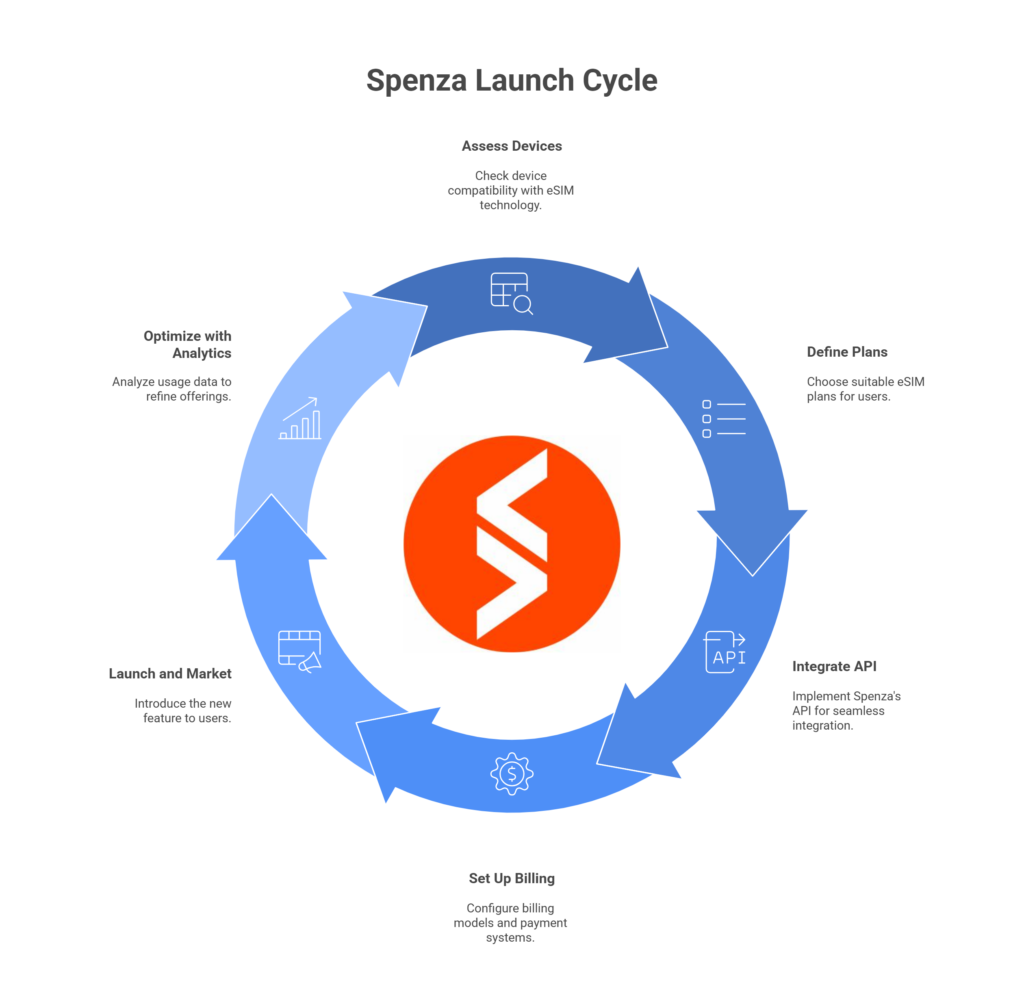
- Assess Your Devices: Confirm which models already have eSIM chips. Many wearables, tablets, and IoT boards already do. If you’re not sure, Spenza’s IoT eSIM introduction covers hardware requirements.
- Define Your Plans: Decide between pay-as-you-go packs, subscriptions, or bundled offers. You can also test hybrid models for different user segments.
- Integrate the API: Use Spenza’s developer documentation to integrate the travel plan store into your device OS or app. Your customers see your brand, your pricing, your offers.
- Set Up Billing: Choose your preferred billing model in Spenza’s backend. Connect your payment provider for direct payouts.
- Launch and Market: Announce the new travel feature in your user base. Position it as a convenience and a cost-saver compared to traditional roaming.
- Optimize with Analytics: Track adoption and usage. Adjust plan sizes and pricing. Offer targeted discounts to high-value travelers.
Because Spenza has already done the heavy telecom lifting, you can move from idea to market in weeks, not years.
How Spenza Handles Scale
Selling travel eSIM solutions to a few hundred customers is one thing. Doing it across hundreds of thousands of devices is another. Spenza’s architecture is designed for that scale.
- Elastic provisioning: Handle spikes during holiday travel seasons without capacity issues.
- Global redundancy: Multiple data centers ensure provisioning and billing run smoothly across time zones.
- Carrier diversity: If one network in a country has an outage, the eSIM can switch to another carrier in the same market.
This reliability is essential if you want customers to trust your brand’s travel plans over their carrier’s roaming offer.
Conclusion: Transform Your Devices from Products to Global Companions
Your devices are already in your customers’ pockets, on their wrists, or in their operations when they travel abroad. The missing piece is a simple, branded way to keep them connected. That’s what travel eSIM solutions deliver.
This is no longer a complex telecom project. With Spenza’s platform, eSIM for device manufacturers becomes a software integration and a marketing plan. You can sell global data plans, manage them in your own systems, and keep your customers connected wherever they go.
The technology, the market, and the customer demand are all in place. The only decision is whether you want that revenue flowing through your brand, or someone else’s.
FAQs
A regular eSIM is tied to a single carrier plan, usually in one country. A travel eSIM solution lets the same chip download different carrier profiles as the customer moves across borders. This keeps devices connected without roaming charges.
Yes. Spenza’s API-first design means you can embed international eSIM plan purchases directly into your app or OS. Customers never need to leave your brand’s environment to buy or activate a plan.
Any eSIM-capable device, smartphones, smartwatches, tablets, laptops, and IoT hardware. Spenza’s IoT eSIM introduction covers technical compatibility.
Most brands use either pay-as-you-go packs, subscriptions, or bundles. Spenza’s analytics help you track usage and test different price points for the best adoption and margin.
Spenza offers multi-carrier connectivity in over 190 countries. If a device enters a country where one network is weak, the eSIM can switch to another carrier in that same market.
Ready to unlock a new global revenue stream from your existing customers? Contact Spenza to learn about our white-label travel eSIM solutions.
